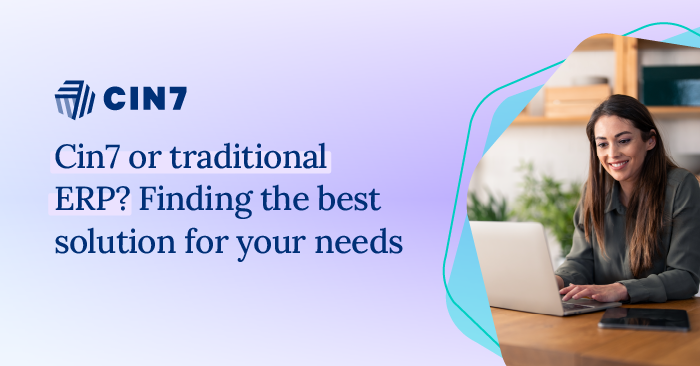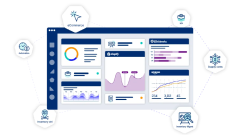
What growing product sellers and manufacturers who are on a mission to evaluate the benefits of traditional ERPs vs. those of inventory management software (IMS) need to know.
In 2025, technology is a—if not the—key factor for businesses to achieve true success in our evolving digital economy. But not just any technology.
As a product seller or manufacturer, you need a powerful, comprehensive business management solution with extensive inventory, supplier, production, warehouse, and order management capabilities that allow you to flex in the face of unpredictability while also helping you boost productivity, improve employee satisfaction, and enhance customer engagement.
Your mission is to select the right solution for your business: a traditional ERP system or modern inventory management software (IMS), like Cin7.
While both technologies yield an abundance of benefits, only one delivers them with less effort at a more attractive price.
Which one? Let’s review their respective offerings to find out.
What you get with a traditional ERP
ERP is short for enterprise resource planning, and it’s technology with roots in the manufacturing industry. Simply put, a traditional ERP is a unifying solution that collects, stores, and analyzes company-wide information and aids businesses in managing and automating business functions, such as accounting, sales, marketing, human resources, and more.
However, not all ERP systems are the same.
Most provide core features, such as accounting (e.g., General Ledger, Accounts Payable (AP), Accounts Receivable (AR), etc.), standardized and customized business reporting, and basic customer relationship management (CRM). Additionally, many ERPs offer inventory, order, manufacturing, and project management functionality within the system, but if they don’t, they typically make them available via integrations in addition to other applications, such as human resources management, point of sale (POS), commerce channels, shipping methods, and tax services.
What you get with Cin7
Tracking inventory has been a necessary practice since ancient times. Through the centuries, the methods for tracking inventory improved—especially with the advent of computers in the 1950s. The creation of inventory management software (IMS) catapulted inventory accuracy and efficiency to new levels, replacing slow, manual practices with automated, real-time capabilities.
Now, IMS enables product sellers like yourself to view inventory at every level, from sourcing, production, storing, and selling to billing, reporting and restocking—with just a click of a button.
But like ERPs, not all IMS options are created equal.
Most inventory management solutions supply you with the tools needed to manage the inventory lifecycle. Unfortunately, they often lack the ability to produce seamless business performance—which is where Cin7 comes into play.
With Cin7, you manage less, sell more, integrate anywhere, see everything, streamline all operations, and drive growth from a single, connected solution. Though Cin7 doesn’t offer built-in accounting functionality like most ERPs, it does natively and seamlessly integrate with powerhouse accounting software platforms QuickBooks and Xero, delivering an affordable solution with unmatched inventory and accounting functionality.
Altogether, Cin7 provides:
- Product Information Management (PIM) for centralized storage of all product information.
- Inventory Management, including Pick, Pack, Ship; warehouse management (WMS); and inventory counts/stocktake for accurate inventory data.
- Order Management that helps you effectively manage Sales, Transfer, and Purchase Orders.
- Purchasing and Supplier Management, which delivers AI-driven inventory suggestions and automated reordering for free-flowing inventory purchasing and management.
- Manufacturing capabilities, such as Bill of Materials (BOMs) with Routings/BOOs; work centers; quality assurance; Material Requirements Planning (MRP), which is an add-on available to any customer; and Master Production Scheduling (MPS).
- Reporting that provides 100+ customizable pivot table reports on available inventory, cash flow, COGS, forecasting based on historic sales data, and more.
- Demand Forecasting that goes beyond MRP through Foresight AI—an advanced tool that uses algorithmic sales forecasting and automatic inventory replenishment.
- Returns Merchandise Authorization (RMA), which works for all marketplaces you sell on.
- Native integrations that eliminate the frustrating and potentially expensive use of an iPaaS to make integrations like Amazon, eBay, Shipstation, Avalara, 3PL, EDI, and much more work, delivering real-time data synchronization, reduced manual entry, and faster implementation.
- Built-in Point of Sale (POS) delivering integrated inventory management, omnichannel fulfillment options, unlimited outlets and registers, and tiered staff access.
- B2B Portal for a simple and complete wholesale buying experience with one place for buyers to review customer catalogs, place orders and manage delivery timelines.
And Cin7 offers Cin7 Capital, the first embedded lending solution in the inventory management industry. Cin7 Capital connects product sellers and small to midsize businesses (SMBs) to vetted funding sources directly within their software, helping them drive operational growth.

Differentiators between traditional ERP and Cin7
Both traditional ERPs and Cin7 equip product sellers with the tools required to manage their specialized inventory needs as well as their overall operational requirements, but how do these two business management solutions compare in terms of cost and implementation timeframes?
Cost differentiators
The true cost of a traditional ERP is challenging to pin down. It can run from the hundreds of thousands to the millions, depending on the ERP vendor you choose and their specific pricing structure.
For example, SAP ERP pricing is largely dependent on business size, number of users, customization requirements, deployment method, and data transfer needs. Determining the cost for Oracle NetSuite is similar, with operational complexity, the modules selected, and which implementation partner you choose. And Acumatica offers a different pricing structure, which is based on the number of integrated applications implemented, your projected resource consumption, and licensing needs.
If you choose a traditional ERP like these, it’s critical that you find out any monthly/yearly fees, implementation fees, and support fees that may not be included in the initial cost or hidden from you during the decision-making process.
For Cin7, costs are clearly broken down into two options: Core and Omni.
Cin7 Core offers Standard, Pro and Advanced options to businesses that need out-of-the-box features for selling online and in-person, advanced manufacturing capabilities, or both. Cin7 Omni is a comprehensive option for businesses requiring custom configurations or EDI and 3PL capabilities. Separate from the monthly fee for either Core or Omni are add-on applications available at an additional cost.
Implementation timeframes
As for how long implementation takes for traditional ERP and Cin7, there is a significant time difference. An ERP implementation can take a few months to a year, depending on size and scope of the project. In comparison, Cin7 may take a few weeks up to a couple of months to complete.
The time difference is important but so are the additional costs associated with a longer implementation project. Because you’ll still be paying for your old solution while implementing the new one, it’s critical that you factor in the costs associated with an extended process.
When Cin7 is the right choice for your business
In a side-by-side comparison, it’s clear that ERPs and Cin7 offer sophisticated features that businesses can use to succeed in today’s digital marketplace. Still, knowing which one is best for your business can be challenging, so here are six questions designed to help you make the right decision:
- Are you a small or midsized product seller or manufacturing business that needs a comprehensive inventory management system to manage your resources and streamline your order fulfillment processes but don’t want a complex, rigid solution nor have to overpay for features you won’t use?
- Are you adding a second sales channel and outgrowing your manual, error-prone inventory spreadsheets?
- Are you growing from one to multiple warehouses?
- Are you wanting to switch to a 3PL?
- Are you expanding your team and want to be able to train every employee on the same system across various departments?
- Are you planning to modernize your tech stack without getting rid of your current software (e.g., QuickBooks or Xero) so that your internal or external accounting team members can continue to offer superlative, uninterrupted and compliant services?
If you answer “yes” to any or all these questions, then Cin7 is likely the better choice for your business.
Cin7: Delivering enterprise-level features and service without the enterprise price tag
Cin7 takes the complex out of inventory management. As a product seller or manufacturer, you’ll be able to easily manage less, connect more, and scale smarter—and pay less than a traditional ERP.
Cin7 customer Yiddi Paplanos, owner and CEO of YP Signal says, “Before Cin7, I was a hot mess. We were losing money every single day. Everything was in my head and my gut. Now, we have everything set up. We don’t have to change anything, and a lot of credit goes to the actual software.”
To learn more about how Cin7 is a wise and affordable alternative to traditional ERPs, contact us for a free demo today.
More from the blog
View All Posts
How to execute a year-end inventory count
Read More
Identifying and navigating the Sustaining Success stage of business growth
Read More


